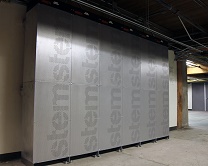 NATIONAL REPORT—Last fall, Stem, Inc. announced it had finalized an agreement to deploy advanced energy storage systems and real-time energy intelligence software across 68 of Extended Stay America, Inc.’s California locations. Approximately two months ago, the Shore Hotel in Santa Monica, Calif. officially unveiled its Green Charge Networks intelligent energy storage system. The Extended Stay America properties, Shore Hotel, San Diego’s Ocean Park Inn and many others have all installed energy storage systems. As battery storage technology has improved—Tesla announced this past May that it would enter the energy storage market—an increasing number of hotels are investing in energy storage systems to help reduce demand charges that typically account for at least 30 percent of a commercial electricity bill, and often as much as 50 percent. Demand charges are based on the highest 15 minutes of electricity usage each month.
NATIONAL REPORT—Last fall, Stem, Inc. announced it had finalized an agreement to deploy advanced energy storage systems and real-time energy intelligence software across 68 of Extended Stay America, Inc.’s California locations. Approximately two months ago, the Shore Hotel in Santa Monica, Calif. officially unveiled its Green Charge Networks intelligent energy storage system. The Extended Stay America properties, Shore Hotel, San Diego’s Ocean Park Inn and many others have all installed energy storage systems. As battery storage technology has improved—Tesla announced this past May that it would enter the energy storage market—an increasing number of hotels are investing in energy storage systems to help reduce demand charges that typically account for at least 30 percent of a commercial electricity bill, and often as much as 50 percent. Demand charges are based on the highest 15 minutes of electricity usage each month.
According to John Carrington, CEO and Director of Stem, who wrote about demand charges for Green Lodging News in 2014 (see article), more and more, hotels are looking to advanced energy storage and data analytics systems to alleviate demand charges. These systems combine predictive software and safe, reliable batteries to proactively store and discharge energy for optimal economic impact. The systems can access energy reserves during times of peak electricity demand to avoid short-term usage spikes and the corresponding demand charges—all with no human intervention or impact to operations. Intelligent storage systems can also provide personalized energy recommendations based on a hotel’s specific electricity needs and usage patterns.
Mitigating demand charges is especially critical where demand charges are most expensive—California and New York, for example. Demand charge rates for three of California’s largest utilities have risen substantially in the past few years, and are about 75 percent higher when compared to 10 years ago.
Vic Shao, CEO of Green Charge Networks, says a big chunk of the cost of energy storage is battery technology. Green Charge Networks took a step toward alleviating the cost of battery storage systems last month with its announcement that it had partnered with Nissan to deploy second-life vehicle batteries for commercial energy storage markets. The first system is set to be placed this summer at a Nissan facility to offset demand charges. “[The vehicle batteries] drive down the cost of our system and allow us to go into markets or applications that previously were not possible,” Shao says.
A ‘Fairly New’ Technology
“The idea that energy storage can be used to mitigate demand charges is fairly new,” says Gabe Schwartz, Marketing Manager for Stem, Inc. “Batteries have to be effective and the system has to know the building’s energy profile. It needs to know when to release stored energy.”
At the Ocean Park Inn in San Diego, an 18 kW system was activated in June 2014 and has reduced demand charges by 10 percent. Stem generates monthly energy savings by learning the hotel’s energy usage patterns, charging when energy prices and demand are low and deploying stored power to offset costly peaks. The facilities staff is free to manage other operations while Stem automatically stores and deploys in the background.
Beyond automated storage, the inn’s CEO, Elvin Lai, furthered savings by spreading out energy-intensive activities with the help of Stem’s PowerScope software platform. Stem’s software displays real-time and predicted energy use, providing visibility into how the hotel’s energy usage patterns translate to costs. With this insight, hotel staff can assess the value of operational changes they are considering and predict monthly energy costs before the bill arrives.
“When I see how my peak rates differ throughout the day, I can spread out hotel activities to further help prevent high demand peaks,” Lai said. “It makes our operations more efficient and
consistently saves us money.”
A combination of San Diego Gas & Electric’s energy storage incentives and Stem’s financing plan allowed Lai to activate the system for no upfront costs. Automated savings from Stem’s system are expected to save the Ocean Park Inn an average of $4,500 per year.
Vehicle Charging Causes Demand Spikes
 At the Shore Hotel in Santa Monica, Calif., electric vehicle (EV) charging is a sporadic, high-usage activity that creates a spike of demand on the grid, triggering a demand charge. Even a couple of EV charges per month can result in a surprisingly high addition to the hotel’s energy bill. To mitigate the effect of those spikes, the Shore Hotel chose to link their EV charging station to an energy storage solution from Green Charge Networks called GreenStation. Green Charge Networks was able to show how its energy storage solution could identify the EV charging draw and immediately discharge enough power to avoid a demand charge-inducing spike. Based on the hotel’s usage history, Green Charge Networks projected that Shore Hotel would reduce its demand costs by as much as 35 percent. There was no charge to install or maintain the energy storage system.
At the Shore Hotel in Santa Monica, Calif., electric vehicle (EV) charging is a sporadic, high-usage activity that creates a spike of demand on the grid, triggering a demand charge. Even a couple of EV charges per month can result in a surprisingly high addition to the hotel’s energy bill. To mitigate the effect of those spikes, the Shore Hotel chose to link their EV charging station to an energy storage solution from Green Charge Networks called GreenStation. Green Charge Networks was able to show how its energy storage solution could identify the EV charging draw and immediately discharge enough power to avoid a demand charge-inducing spike. Based on the hotel’s usage history, Green Charge Networks projected that Shore Hotel would reduce its demand costs by as much as 35 percent. There was no charge to install or maintain the energy storage system.
Through a partnership with NRG eVgo, Green Charge Networks had installed a Fast DC charger in a designated space in the hotel’s parking garage, adjacent to a 60 kWh-capacity Green Charge Networks lithium ion-based energy storage system. At the heart of the system is a smart controller with software that monitors facility loads on a second-by-second basis and automatically discharges or charges the storage system as needed to flatten the power load curve. Green Charge Networks monitors the system over the dedicated network, and reports on the savings in demand charges, which it shares with Shore Hotel.
“Energy storage is a natural complement to the many measures we’ve taken to reduce our carbon footprint and achieving LEED Gold certifications,” said Steve Farzam, CEO at Shore Hotel.
Having an energy storage system does not necessarily require much space or time commitment. Stem’s Schwartz says an 18 kW system has a footprint of only two square feet and is about the size of a gym locker. Maintenance is included in any purchase. “There is no need for anyone to do anything on-site. Data is sent back to the operations center. We can usually do a fix remotely.”
Engineers can, however, actively benefit from using the software that manages the energy storage systems. For example, information that a peak is going to be set could prompt one to delay laundry for 30 minutes. Stem software allows one to receive alerts—to know if something is turned on when it should not be.
InterContinental Hotels Deploying Systems
Schwartz says his company first runs a simulation model to determine system size. One of Stem’s customers is the InterContinental San Francisco. That property has a 100 kW system. Two InterContinental properties are currently using Stem systems and there are plans to roll out the technology to an additional 12 InterContinental hotels.
In California, incentives are in place to help pay for energy storage systems. “We have worked with utilities in every state to make this more viable,” Stem’s Schwartz says. “Before we went to market, we bought a group of financing. The financing we bring allows a hotel to not pay for installation. You just pay one low monthly fee and you keep the savings. Hotels don’t have to pay for the hardware.”
Like Stem, Green Charge Networks also makes it easy to get started with a battery storage system. Through a Power Efficiency Agreement (PEA), installation and maintenance is free and energy bill savings are shared.
Glenn Hasek can be reached at editor@greenlodgingnews.com.





